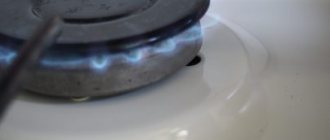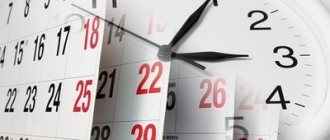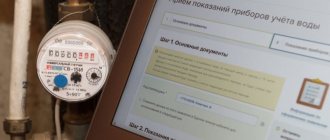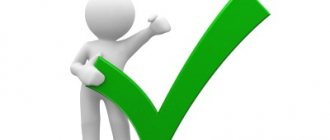Here you will learn:
- Is it profitable or not to install water meters in an apartment?
- Which water meter is better to install?
- Legal subtleties and practical solutions
- Rules for installing water meters in an apartment
- Install water meters - yourself or through a company
- Preparatory activities for installation
- Installing water meters yourself
- Seal installation and technical documentation
- Problems during operation and their solutions
The rules for installing water meters in an apartment determine who, where, how and how the meter should be installed. This can be done with the assistance of a specialist, or you can do it yourself. In any case, after installation, you must call a specialist to seal the metering device.
Is it profitable or not to install water meters in an apartment?
There is no longer any need to think about whether a water meter is needed or not - a law has been passed according to which everyone is required to install one. But many people wonder how profitable it is. If there are as many people living in the apartment as registered or less, installing a meter is beneficial. It is also beneficial if, say, someone moves to a dacha for the summer or spends a vacation there. If the situation is diametrically opposite - fewer people are registered than live, it is not profitable for you to install a meter. But there is no escape from this.
You only pay for what you use
How big the savings will be for permanent residence depends on the calculation method adopted in your management campaign and how intensively you use water. At a minimum, you will save about 30%, but there have been cases when payments after installation were reduced significantly. This may happen if the house has a common meter. In this case, based on the results of the month, the consumption of those residents who have meters installed is subtracted from the total readings, and the remainder is divided among the remaining apartments according to the number of registered people. Usually those who actually have more people living with them than registered do not install meters. In this case, the monthly consumption per person can be 8-10 cubic meters of cold and approximately the same amount of hot water. In fact, even if you don’t save much, you get about 3 cubes of cold and 2 hot. So it really does make sense.
Is it necessary to install a water meter in an apartment or private house?

- The laws have not yet addressed the issue head-on: establish, otherwise there will be a fine and administrative liability.
- In some cases, installing a control panel is not profitable: if one person is registered in an apartment, but five live, it is more profitable to pay according to the standards.
However, legislation is systematically changing, and rational use of resources and optimization of consumption calculations are becoming a priority.
The use of water meters is not only favorable from a legislative point of view, but also economically beneficial for the user.
Which water meter is better to install?
Devices that are used to record water consumption are installed on plumbing structures in houses and apartments. Communications must be connected to a centralized network. When choosing a specific device, it is recommended to focus on some individual factors:
- state of communication;
- water quality (it may contain foreign inclusions);
- own financial capabilities;
- temperature of the medium transported through the pipes.
In addition, it is recommended to find out how much it costs to install a water meter. Self-installation is a rather complex undertaking, which is not always within the capabilities of an unprepared person.

Installation of water meters can be carried out on pipes with different diameters
The first criterion by which water meters are classified is the source of energy consumed for operation. Depending on this indicator, two groups of metering devices are distinguished:
- non-volatile;
- volatile.
In the first case, the operation of the device is carried out due to natural processes that occur during the operation of the device. In turn, energy-dependent water meters require electricity.
Installation of water meters can be carried out on pipes with different diameters. For example, the smallest cross-section in this case is only 15 mm. The maximum diameter is 20 mm.
Volatile devices are divided into several subgroups. These include electromagnetic models, as well as ultrasonic and vortex devices. Equipment for which the presence of natural processes is sufficient is called tacheometric. Among other things, water meters are divided into classes depending on how many pipelines they serve (single-channel, double-channel, etc.).

Depending on the source of energy consumed for the operation of the device, two groups are distinguished: non-volatile and volatile
Installation rules
So, let's move on to the main question - how to properly install a water meter. You need to start by contacting the water utility. There are certain laws that must be followed. As for private houses, today the meter must be installed outside the house. The reason is free access to it by representatives of the water supply organization. That is, so that they simply do not enter the house. And if the owners are absent, the inspector himself can take readings.
There are two situations related to the installation of a water meter:
- The house is just under construction.
- The house is in use and needs to be connected to an existing water supply.
Legal subtleties and practical solutions
The interpretation of the meaning of the act implies that the owners of the premises are obliged to ensure that the resources supplied by the relevant organizations are accounted for. This means that a consensus must be reached between the supplier and the consumer on the procedure for accounting for resources and the equipment used. The accounting procedure is ensured by the integrity of the device, that is, the meter, which is sealed by a representative of the organization supplying water. In general, this is a management or housing and communal services office.

Sectional view of a water meter.
Measuring equipment approved for installation for metering water consumption is entered into the database of the Federal Information Fund for Ensuring the Uniformity of Measurements and is available for review at fundmetrology.ru. The passport of the purchased measuring device must indicate the registration number of this type of equipment in the Information Fund database. Additional testing or inspection of the purchased device is not required, but in order to avoid unnecessary misunderstandings, this issue should be previously agreed upon with the operating organization.
Meters may not be installed if the building is considered dilapidated and there are relevant documents stating this situation. A building with a significant degree of wear and tear has communications in appropriate condition.
It is simply dangerous to install any equipment on them. It should be added that the refusal of the homeowner to install water meters is not a punishable action. In this case, payment is provided at an increasing rate, but no administrative or punitive sanctions are expected.

Installation elements of the system.
When installing a water meter in an apartment or house, two related procedures arise, which can be performed separately or simultaneously, depending on prevailing local characteristics and practices. The first procedure is the installation of equipment on the water supply system.
The owner of the premises can do it himself or involve specialists, including those associated with the operational office that supplies drinking water to his apartment or house. This does not violate the rules and procedure for installing water meters in the apartment. The work is carried out at the expense of the owner of the premises.
The second procedure is the acceptance of devices into operation by the management organization, which will receive money for the resources received, based on the readings of installed measuring instruments. Sealing of meters and, if necessary, other elements of the system is carried out by a representative of the management office. The procedure should be performed by them free of charge.
If the installation of the measuring equipment is carried out by a company authorized by the resource supplier to accept it into operation, both procedures can be completed in one stage.
Rules for installing water meters in an apartment
Regulations regulating the use and installation of metering devices are mandatory for all participants - users, resource providers and service companies.
Requirements for metering devices. Devices manufactured in accordance with GOST R 50601 and 50193 and included in the register of measuring instruments are allowed for installation. The diameters of the device’s pipes must correspond to those common in the Russian Federation. The design of the device must exclude the technical or physical possibility of changing the readings.
Technical requirements for the operation and installation of water meters in the apartment. The rules dictate:
- where to install water meters - the location of the devices should be accessible to both the resource supplier and the user himself, and the room temperature should not fall below 5 °C;
- sealing the device, the procedure is free for the consumer;
- registration of the installed device;
- regular transmission of evidence to regulatory authorities;
- verification, repair or replacement of the meter by the homeowner;
- for organizations carrying out water supply systems, the obligation to install, replace and verify water meters at the request of the consumer and at his expense, but with possible installment payments;
- service companies must have the appropriate license to carry out work on installing metering devices.
The homeowner should remember that neither the organizations supplying water resources nor the management of the condominium can impose any meter models or services. If the housing is considered dilapidated, the project for installing a water meter must be approved by the responsible organizations.
Install water meters - yourself or through a company
Many users are afraid to do the installation themselves. There is a prejudice that such a procedure is illegal.
However, in reality, only residents decide whether to do the work themselves or turn to professionals.
In the first case, you will need to have some tools and figure out the water supply system, but this will save money. When choosing the second option, the user will face financial costs, but he will save his own effort and time.
Preparatory activities for installation
Any metering devices should be purchased in specialized stores, and not from hand or on the market. In this case, when purchasing, you need to check the package contents of the product, the presence of a technical passport, and also check the number indicated in the document with the number on the device itself. This way you can be sure that you have purchased certified products suitable for use.
After purchasing and before installing a meter in a house or apartment, you need to take it, along with the accompanying documentation, for verification to the state office of control and measuring devices (I&I) of the housing office or to the water utility department. It is not prohibited to use the services of private companies to check the operation of metering devices, but the company must be licensed.
After verification of the technical product, a stamp will be placed in its passport, and after installing the water meter, a seal will be installed on it, which must absolutely not be damaged or removed, otherwise problems will arise with registering the device. After checking the metering device, you can begin to develop a water meter connection diagram and prepare for installation.
Meter installation specialists advise preparing in advance all the necessary tools and materials for installation work. First of all, you need to purchase paronite gaskets for a hot pipeline and rubber gaskets for a cold one. Also, most likely, you will need special sealing pastes and plumbing tow, or synthetic threads that already contain silicone grease.
The set of necessary tools depends on the type of pipeline, a certain section of which will have to be cut, so you will need a hacksaw for metal or a saw for plastic. You will also need:
- prepare a tool for cutting threads on metal pipes in order to install a block of meter and pipes;
- purchase cutting scissors, connecting fittings and a special soldering iron if the pipes are made of plastic.
In addition, you will need spanners and adjustable wrenches of the appropriate diameter to tighten the connections. At the same time, it is important not to overdo it, so as not to “tighten” the installed threads.
To check the equipment of the device, you need to lay out all the elements of the block on a flat surface in the direction of the water flow:
- The shut-off valve (if included) allows you to shut off the flow at the right time. To regulate the water supply, you will also need a valve.
- A mechanical filter for retaining insoluble impurities and a coarse filter for removing debris from water. Capable of extending the service life of the meter, they are installed in front of the device.
- The first connecting pipe (with a union nut - American).
- The water meter itself.
- Second connecting pipe.
- A check valve that retains water in the system prevents reverse rotation of the impeller when the water supply is turned off.
When laying out the elements of the meter block, you need to pay attention to the arrows that indicate the direction of flow. All arrows must be in the same direction. Before installing hot and cold water meters yourself, you must turn off the water supply. In an apartment building, you will need to shut off the entire riser, which only utility workers have the right to do.
Legal aspects of self-installation
The legislation does not provide for categorical prohibitions on the manifestation of such independence. The main thing is to use common sense and comply with regulatory requirements and installation rules during installation.
But in most cases, their connection is carried out by specialized organizations that have appropriate permission to perform this type of work.
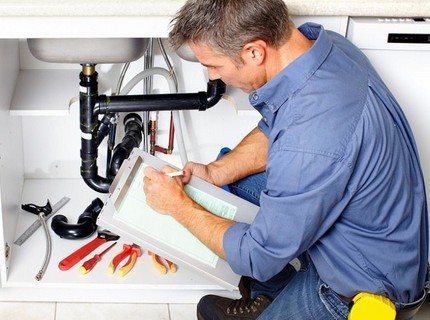
Licensed organizations install metering devices, strictly observing the requirements and procedure for putting installed metering devices into operation
If you are forced to use the services of specialized companies, be aware that this is illegal. You can do the procedure of inserting into an equipped water supply system on your own.
When installing equipment, it is worth considering a number of points:
- Purchase devices only from licensed companies. The device must be accompanied by a technical passport.
- Installation of equipment involves shutting off the water supply through the riser, which is quite problematic to do on your own.
- When installing and connecting the device, it is important to follow the water meter connection diagram and strictly follow the technology. Otherwise, if the pipeline breaks, all losses will have to be reimbursed from your wallet.
In order for the readings of a self-installed water meter to be accepted when calculating utility bills, it is necessary that they be sealed and placed on the balance sheet of the local Vodokanal branch.
Installing water meters yourself
Replacement or installation of meters can be done by residents. Changing the device is much easier, but there may be some problems with the initial installation.
The most important thing is to prepare the documents correctly and carry out installation with special attention.
There is one suitable place for installation, this is immediately after the riser, on the first straight section of the pipe. This applies to hot and cold water.
You will need to install three elements: a meter, a faucet and a coarse filter. Once the circuit is completed, the wiring is installed.
All modern elements are threaded and installing them is not difficult. The main thing is to know that the tap will need to be opened and access to it should be provided; the filter must be directed downward, and the counter must be clearly visible.
Some experts recommend installing a check valve so that the water flow does not change. This helps to achieve stable performance in the event of pressure changes.
Simple scheme
Sequential installation of all necessary elements.

Faucet, filter and counter.
Check valve circuit

A check valve is added to the simple circuit to stabilize the meter readings.
Diagram with shut-off valves

For convenience, a shut-off valve is installed; with its help, you can always turn off the water supply in order to replace the meter.
Scheme with pressure reducer

Precise pressure regulation allows you to get the correct readings, regardless of the water supply.
Water meter installation diagram
It doesn’t matter whether you install the meter through a company or with your own hands, you need to know what the correct diagram should look like - it is very desirable to control the process.
Where and how to install: choosing a location for a water meter
The meters are installed immediately after the riser in a straight section before the first branch to the plumbing fixtures. There are water meters that can only be installed horizontally, while there are models that can be installed vertically. Just keep in mind that in a horizontal position the accuracy of the device is higher than in a vertical position and it is not a fact that it will count less. So it is very advisable to find a way to place it “lying down”.
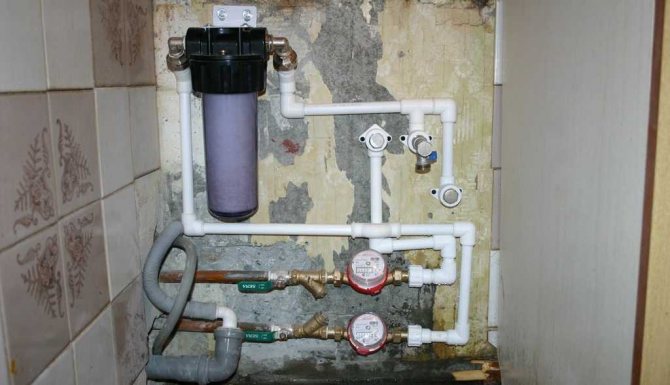
It is advisable to install water meters horizontally
What and why should be in the diagram
The standard water meter installation diagram looks like this:
- a ball valve is screwed onto the pipe coming from the riser,
- a coarse filter is installed,
- counter;
- Next is the wiring.

Installation of water meters with a minimum number of elements
Now let's take a closer look at what each element is needed for.
A ball shut-off valve is needed to turn off the water if necessary - to repair the faucet, clean the filter, change the meter, etc. Therefore, its presence is mandatory. It must be placed so that it is convenient to turn the valve.
The coarse filter catches the largest particles that are in the water supply. It must be installed so that the outlet is directed downwards. Otherwise it will clog quickly.
All these elements most often have internal threads. So that they can be connected to each other, connecting elements are used, which are often called “slopes”. They have external threads on both sides and a small section of flat pipe (in some versions, only a few millimeters). with their help everything is connected to each other.
Read what types of water filters there are and how to get clean water here.
Optional Schema Elements
Often a check valve is installed after the meter. It is required so that in the absence of analysis, water does not flow in the opposite direction. This also prevents the reading from increasing in the presence of unstable pressure.
It also cuts off two more unpleasant situations: and prevents cold water from flowing from one pipeline to another. This happens if someone has a hygienic shower installed on the riser (on the toilet or bidet), a shower stall with cheap faucets. They do not have check valves and such overflow is possible.
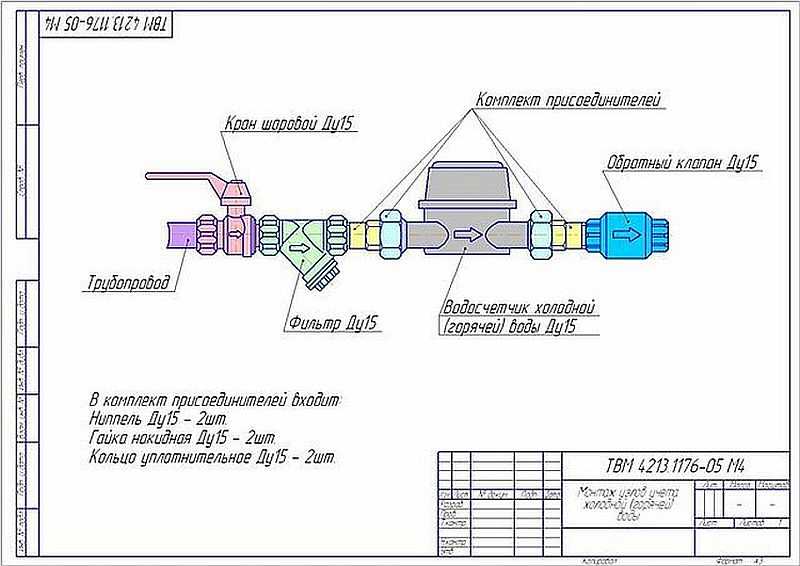
Check valve circuit
If the pressure of cold water is higher than hot water, then cold water reduces the temperature of the hot water supply, and in the opposite situation, hot water can flow from the cold water tap. Therefore, installing a check valve for both cold and hot water is highly desirable, but not required.

Installation diagram of a water meter with shut-off valves on both sides
Sometimes it is recommended to install another shut-off valve after the check valve. It is needed so that when removing the meter or when cleaning the same filter, water from the pipes in the apartment does not drain onto the floor. In principle, you can substitute a container, but this is not always possible. There are about 6 liters of water in the pipes of an ordinary apartment; collecting water from the floor is not the most pleasant task. But this element of the harness is installed or not at the request of the owner.
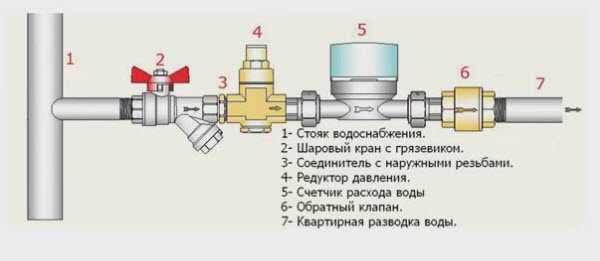
Scheme with pressure reducer
There is another device that can be installed - a pressure reducer. It stabilizes the pressure in the system, extending the “life” of all household appliances and taps/mixers. Placed after the coarse filter. Not the cheapest thing, but very useful.
Read here how to choose a filter for your sink to obtain drinking water.
Seal installation and technical documentation
After you have installed the metering unit and checked that it is working properly, the question arises, how to properly seal the water meter? You should find out who is doing this, whether it is possible to put a filling yourself.
You should entrust the installation of the seal to specially trained people: representatives of the water utility or the management company. To do this, you must submit an application to receive a meter.
Do not hesitate to apply, despite the installed meter, water consumption will still be determined at the maximum before official registration.
And you will be able to pay the meter only after completing the official sealing procedure. Information on how to do this correctly is described in detail in our other article.
Installing a filling is a free procedure. You shouldn’t install it yourself; you’ll still have to call a representative of the management company.
Within some time, usually from three to five days, a local government representative will be sent to respond to your application. For normal working contact with him, you must have a verification certificate and a meter passport with you.
The specialist’s responsibilities include checking the correct installation order of the water meter unit and all its components, and also checking the integrity of the unit elements.
The water utility representative does not have the right to control the qualifications of the person installing the meter.
After checking and sealing the unit (with his own seal), the inspector will draw up a commissioning report, where he will enter the initial meter readings and provide you with a service agreement.
After carefully reading the contract, making sure that you are satisfied with everything, put your signature.
It is not allowed to use data taken from the meter in utility bills if a seal is not installed or there is no polymer film with a verification stamp printed on it.
After signing the contract, you begin to pay for water according to the meter. Among the documents, the owners should have one copy of the service agreement and the act of putting the meter into operation.
It is also necessary to leave a technical passport and a certificate of verification of the water meter. An employee of the management company will need a technical passport; it is better to make a photocopy in advance.
There are times when re-filling is required. For example, the service life of the devices has expired, one of the elements of the unit has broken, or a new element has been added to the system.
Therefore, it is better to store documents separately from other papers, so that in case of an unforeseen situation they are at hand.
